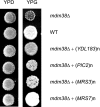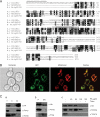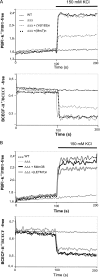Novel components of an active mitochondrial K(+)/H(+) exchange
- PMID: 20197279
- PMCID: PMC2863244
- DOI: 10.1074/jbc.M109.059956
Novel components of an active mitochondrial K(+)/H(+) exchange
Abstract
Defects of the mitochondrial K(+)/H(+) exchanger (KHE) result in increased matrix K(+) content, swelling, and autophagic decay of the organelle. We have previously identified the yeast Mdm38 and its human homologue LETM1, the candidate gene for seizures in Wolf-Hirschhorn syndrome, as essential components of the KHE. In a genome-wide screen for multicopy suppressors of the pet(-) (reduced growth on nonfermentable substrate) phenotype of mdm38Delta mutants, we now characterized the mitochondrial carriers PIC2 and MRS3 as moderate suppressors and MRS7 and YDL183c as strong suppressors. Like Mdm38p, Mrs7p and Ydl183cp are mitochondrial inner membrane proteins and constituents of approximately 500-kDa protein complexes. Triple mutant strains (mdm38Delta mrs7Delta ydl183cDelta) exhibit a remarkably stronger pet(-) phenotype than mdm38Delta and a general growth reduction. They totally lack KHE activity, show a dramatic drop of mitochondrial membrane potential, and heavy fragmentation of mitochondria and vacuoles. Nigericin, an ionophore with KHE activity, fully restores growth of the triple mutant, indicating that loss of KHE activity is the underlying cause of its phenotype. Mdm38p or overexpression of Mrs7p, Ydl183cp, or LETM1 in the triple mutant rescues growth and KHE activity. A LETM1 human homologue, HCCR-1/LETMD1, described as an oncogene, partially suppresses the yeast triple mutant phenotype. Based on these results, we propose that Ydl183p and the Mdm38p homologues Mrs7p, LETM1, and HCCR-1 are involved in the formation of an active KHE system.
Figures












Similar articles
-
Determination of yeast mitochondrial KHE activity, osmotic swelling and mitophagy.Methods Enzymol. 2009;457:305-17. doi: 10.1016/S0076-6879(09)05017-4. Methods Enzymol. 2009. PMID: 19426875
-
Mdm38 protein depletion causes loss of mitochondrial K+/H+ exchange activity, osmotic swelling and mitophagy.Cell Death Differ. 2007 Sep;14(9):1647-56. doi: 10.1038/sj.cdd.4402167. Epub 2007 Jun 1. Cell Death Differ. 2007. PMID: 17541427
-
The LETM1/YOL027 gene family encodes a factor of the mitochondrial K+ homeostasis with a potential role in the Wolf-Hirschhorn syndrome.J Biol Chem. 2004 Jul 16;279(29):30307-15. doi: 10.1074/jbc.M403607200. Epub 2004 May 11. J Biol Chem. 2004. PMID: 15138253
-
LETM1: Essential for Mitochondrial Biology and Cation Homeostasis?Trends Biochem Sci. 2019 Aug;44(8):648-658. doi: 10.1016/j.tibs.2019.04.002. Epub 2019 May 14. Trends Biochem Sci. 2019. PMID: 31101453 Review.
-
The enigmatic role of Mim1 in mitochondrial biogenesis.Eur J Cell Biol. 2010 Feb-Mar;89(2-3):212-5. doi: 10.1016/j.ejcb.2009.11.002. Epub 2009 Nov 26. Eur J Cell Biol. 2010. PMID: 19944477 Review.
Cited by
-
Cell organelles as targets of mammalian cadmium toxicity.Arch Toxicol. 2020 Apr;94(4):1017-1049. doi: 10.1007/s00204-020-02692-8. Epub 2020 Mar 23. Arch Toxicol. 2020. PMID: 32206829 Review.
-
ATP Synthase K+- and H+-fluxes Drive ATP Synthesis and Enable Mitochondrial K+-"Uniporter" Function: II. Ion and ATP Synthase Flux Regulation.Function (Oxf). 2022 Jan 27;3(2):zqac001. doi: 10.1093/function/zqac001. eCollection 2022. Function (Oxf). 2022. PMID: 35187492 Free PMC article.
-
Regulation of the mitochondrial proton gradient by cytosolic Ca²⁺ signals.Pflugers Arch. 2012 Jul;464(1):19-26. doi: 10.1007/s00424-012-1106-y. Epub 2012 Apr 24. Pflugers Arch. 2012. PMID: 22526460 Review.
-
Screening and Genetic Network Analysis of Genes Involved in Freezing and Thawing Resistance in DaMDHAR-Expressing Saccharomyces cerevisiae Using Gene Expression Profiling.Genes (Basel). 2021 Feb 3;12(2):219. doi: 10.3390/genes12020219. Genes (Basel). 2021. PMID: 33546197 Free PMC article.
-
Defective brown adipose tissue thermogenesis and impaired glucose metabolism in mice lacking Letmd1.Cell Rep. 2021 Dec 14;37(11):110104. doi: 10.1016/j.celrep.2021.110104. Cell Rep. 2021. PMID: 34910916 Free PMC article.
References
-
- Mitchell P. (1966) Biol. Rev. Camb. Philos. Soc. 41, 445–502 - PubMed
-
- Froschauer E., Nowikovsky K., Schweyen R. J. (2005) Biochim. Biophys. Acta 1711, 41–48 - PubMed
-
- McQuibban A. G., Joza N., Megighian A., Scorzeto M., Zanini D., Reipert S., Richter C., Schweyen R. J., Nowikovsky K. (2010) Hum. Mol. Genet. 19, 987–1000 - PubMed
-
- Nowikovsky K., Froschauer E. M., Zsurka G., Samaj J., Reipert S., Kolisek M., Wiesenberger G., Schweyen R. J. (2004) J. Biol. Chem. 279, 30307–30315 - PubMed
-
- Nowikovsky K., Reipert S., Devenish R. J., Schweyen R. J. (2007) Cell Death Differ. 14, 1647–1656 - PubMed
Publication types
MeSH terms
Substances
LinkOut - more resources
Full Text Sources
Medical
Molecular Biology Databases
Research Materials

